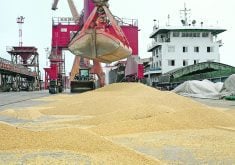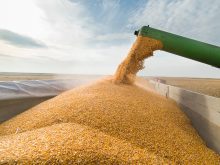Before we get into the markets, I’ll note that this will be my last column as a member of the Western Producer staff.
After about 34 wonderful years in journalism, 21 1/2 of them at this fine newspaper, I am taking early retirement. I am blessed with many interests and look forward to spending more time enjoying them.
I am confident that the high standards in markets coverage that you have come to expect from the Producer will continue to be met by the experienced and knowledgeable reporters whose bylines will continue to grace these pages.
Read Also

Trump’s tariffs take their toll on U.S. producers
U.S. farmers say Trump’s tariffs have been devastating for growers in that country.
I won’t completely depart from the scene, however. I will continue writing this weekly column with the intention of providing information to help you market your crops and livestock and to understand the evolving social and economic factors that drive production and demand.
Looking at the end of 2017, the key factors were the loonie rally, weather issues in Argentina and the U.S. winter wheat belt and the bitter cold in Western Canada that likely slowed grain transportation.
The stronger loonie hammered March canola down to the lowest level in eight months.
The loonie soared about US1.5 cents from the pre-Christmas low to around 79.7 cents as this column was written, supported by crude oil prices rallying near $60 per barrel and some stronger than expected measures of the Canadian economy.
The data indicated that the Bank of Canada might have reason to raise interest rates early in the new year.
Many economists still think the rate hike will come in March, but if December’s economic numbers are again better than expected, then the rate hike might come sooner.
Indeed the economies of many developed countries are finally shaking free from the stagnation that marked the past decade. Central banks will start to unwind the stimulus measures and low interest rates that defined recent monetary policy.
The improving prospects in Europe and Japan are compounding the strong growth that the United States and Canada have enjoyed for more than a year.
This should mean that incomes will start to grow again and consumption patterns will firm up, likely not as strong as the early 2000s but better than most of this decade.
This should help firm demand for meat, which will be needed because meat production, at least in North America, is expected to reach record highs in 2018.
A buoyant world economy would support the demand needed to consume what I expect will be a continuing ample supply of grain and oilseeds.
Rain over the holidays solved Argentina’s immediate problems. And reports from Brazil give me the impression that we could soon see rising production forecasts that will offset any decline in Argentina.
The cold that hammered the Prairies over the holidays poked its icy fingers down into the southern U.S. Plains, where winter wheat is exposed to potential damage.
However, winter wheat is an exceptionally hardy crop that takes a lot while it is in the dormant stage.
Of greater concern is the dry weather across almost all of central North America. If it continues into spring, concerns would rise because the area does not have the soil moisture reserves that carried it in 2017.
The February-April forecast from the U.S. weather service is for warmer and drier than normal weather in much of the southern Plains.
Much can change yet, but the current outlooks are enough to keep some uncertainty in the wheat market, which otherwise sits on comfortable stocks and expectation of another large Black Sea region wheat crop in 2018.














